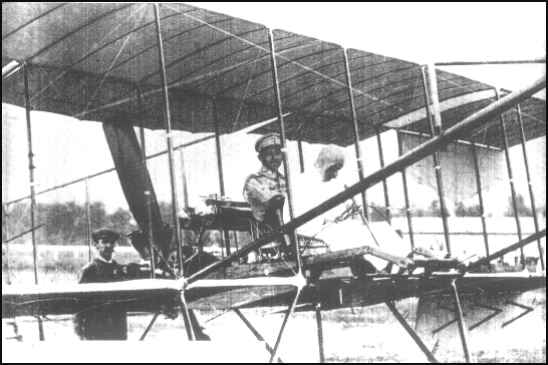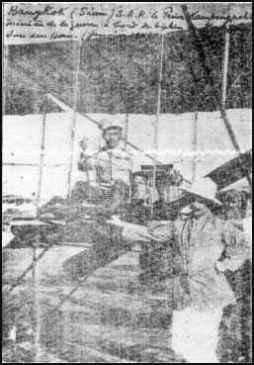
AVIATION IN THAILAND by Niels Lumholdt and William Warren Published by Travel Publishing Asia Ltd. Document courtesy of Stephen Darke Transcribed by Ralph Cooper |
|
Getting off the Ground: The Pioneers |
|
In 1910, to most people of the Western world, the kingdom of Siam was a remote, romantic place of
exotic associations; white elephants and Siamese twins, glittering temple spires and waterways that served as roads. The only country in
Southeast Asia not under colonial rule, it was also looked upon as comparatively backward, despite a number of impressive reforms
intitiated by King Chulalongkorn, who died in October ot that year after a reign or 42 years. Railways still reached only a few of its
provincial areas, many of which involved journeys of days, or even weeks, from the capital, and the wonders of the Industrial
Revolutin scarcely impinged upon the life of the average person. A visitor bringing such preconceptions might thus have been surprised at a letter which appeared in the Bangkok Times Weekly on the last day of that year - the last day, that is, by the Western calender; Siam, offering further evidence of its remoteness, still began the new year in April, as it had for centuries. The letter was from a correspondent who signed himself; "K. Offer", and was mainly devoted to thanking certain groups who had apparently come forward with support for a project he was promoting, among them being "members of the Royal House, the Diplomatic Corps, and the Royal Bangkok Sports Club." Mr. Offer concluded with the following remarks; "I hope the Bangkok Aviation Week will be a success, and though we have to reckon with all sorts of possibilities happening to the aviators and their machines in the meantime and at other meetings, we shall do our utmost to satisfy everybody who has been kind enough to assist us here in Bangkok." Only seven years before, on a beach near Kitty Hawk, North Carolina, two bicycle makers named William and Orville Wright had made the first flight in a "heavier that air craft", thus fulfilling one of mankind's earliest dreams. The feat received little publicity, and when they did hear about it, most people disbelieved it. A few, however, mostly in Eurpe, saw the possibilities and within a short time flying had captured the public imagination in several countries. On July 25, 1909, Louis Bleriot of France got up early in the morning and amazed the world by crossing the English Channel in a monoplane of his own design. Later that year, eight different types of flying machine, six of them designed and built in Europe, participated in the first international aeronautical meeting at Rheimes. And now, within a remarkably short time, distant Siam was about to get its first look at the wonderful new invention. |
 |
|
The first flying demonstration attracted newspaper articles and eminent guests. Above,
Prince Chakrabongse, Chief of the Army General Staff, sits in the plane with the Belgian Pilot. |
|
FEBRUARY 8, 1911 THE AVIATION MEETING Last evening His Majesty the King paid an unexpected visit to the course and watched the proceedings with apparent interest, Subsequently His Majesty went over and inspected the aeroplane and conversed with Mr. Van den Born for some minutes, after which the aviator made a short flight so that the King could see the machine start from close quarters. Among those present yesterday were H. R. H. the Prince of Pitsanulok and H. R. H. Prince Nares. Mr. van den Born had had trouble with his motor all day and only in the evening was it working satisfactorily. After a trial flight, the aviator gave a lesson to an Army officer, going several miles in a few minutes. An exhibition flight in the enclosure for a prize given by Chinese firm, was heartily applauded and admiration was excited by the graceful salute given each time the machine passed His Majesty's stand. Dr. M. A. Smith then was a passenger and had a capital flight out beyond the Police School. It was now getting dark but one more flight was made, Mr. P. Nesbitt being the passenger. Once or twice the aviator stopped his engine and came down at a big speed but a slight movement of the planes always brought the machine parallel with the ground the momentum already acquired being sufficient to enable the aeroplane to glide smoothly along until the desired spot was reached. This morning flights were made by the Prince and Princess of Nagorn Jaisri, Prince Adisorn, and Mrs. Hamilton Price. In each case the flight were quite extended ones and were greatly enjoyed by the passengers. |
 |
|
(Courtesy Bangkok Post Library) |
Prince Purachatra, Commander of the Army Engineers, enjoys a
similar experience. |
|
Mr. Offer's letter suggests that the original plans called for demonstrations by a group of aviators in a
variety of aircraft. If so, some of them may have fallen victim to those "possibilities" darkly hinted at, for only one showed up on January
31, 1911, the opening day of a week long program. He was a Belgian named Van den Born, and the machine in which he proposed to
show the marvel of air travel was a flimsy looking Henri Farman biplane from France that may well have reminded some of the Thais
present of the huge kites flown in annual competitions near the Grand Palace The site selected for the demonstration was the race track of the Royal Bangkok Sports Club, now in central Bangkok but then regarded as being in a fairly remote suburb with plenty of surrounding fields in case of emergency. To accommodate the expected crowds, 15 new entrances had been erected, involving the construction of four bridges across neighboring canals. These precautions seemed justified on opening day, when hundreds converged on the Club, among them such notables as Prince Chakrabongse, Chief of the Army General Staff, and Prince Purachatra, Commander of the Army Engineers, both brothers of the new King Vajiravudh and both soon to play important roles in the development of aviation in Siam. "Whether the biplane is an easy machine to handle or whether the skill of Mr. Van den Born makes it appear so is difficult to tell," reported the Bangkok Times. "At any rate the flights accomplished were to all appearances easy and graceful. The quiet manner in which the machine simply drifted off into the air and the smoothness with which the land was regained elicited much admiration." There is some confusion over whether Prince Chakrabongse or Prince Purachatra was the first Thai to leave the ground in an airplane, though the newspaper accounts suggest that it was the latter, on a test flight the day before the demonstrations officially opened. In any event, both certainlyh flew - "in uniform with riding boots and spurs", according to Lords of Life by Prince Chakrabongse's son - and so did numerous others, payhing 50 baht for the experience. The first foreigner to glimpse Bangkok from the air was identified as a "Mr. F. Bopp" and the first Thai woman appears to have been the Princess of Nagorn Chaisri. |


 Next Page Next Page
|